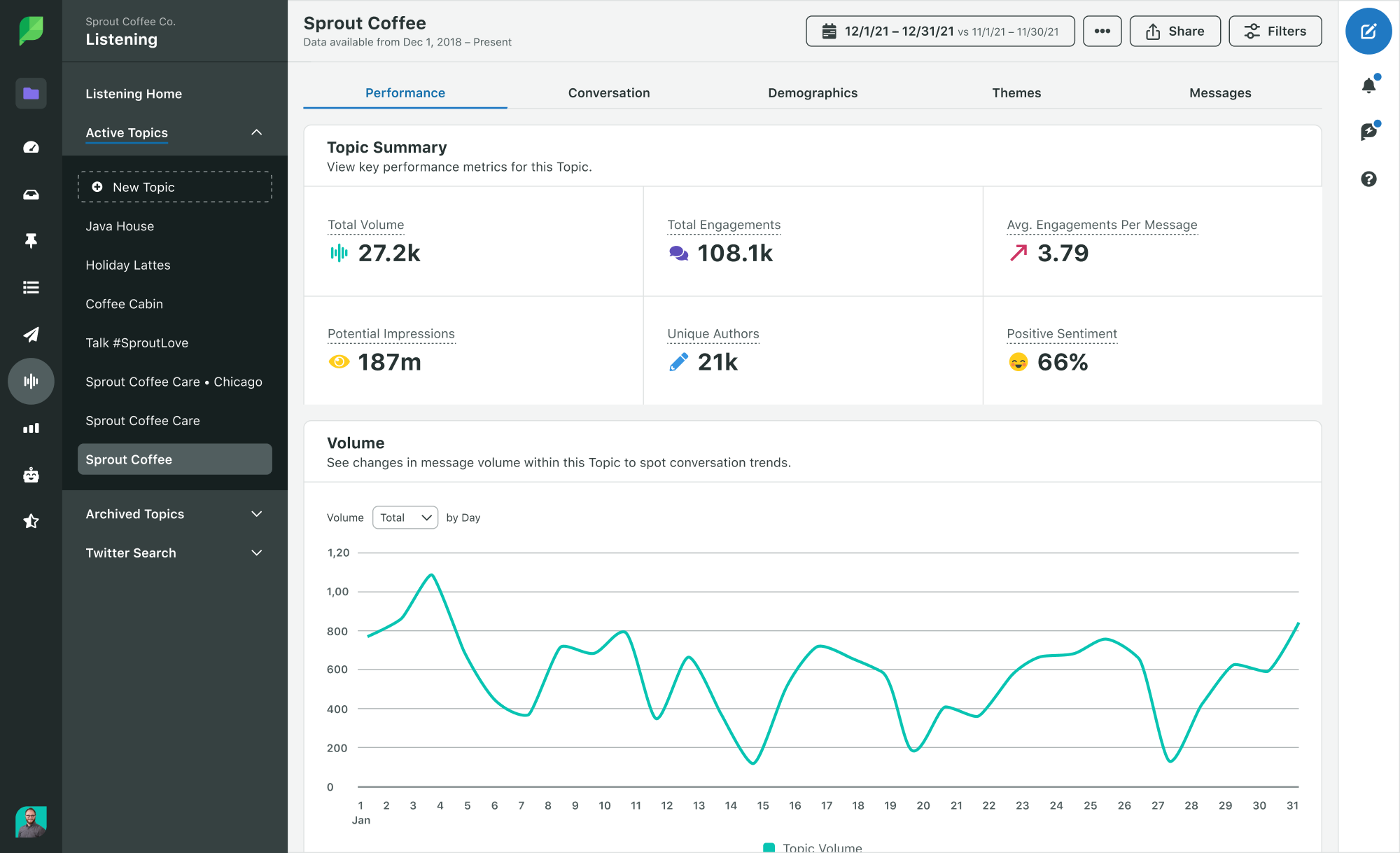Using social listening to surface trends to your audience
Written by Jacqueline Zote
Published on September 9, 2021
Reading time 7 minutes

When COVID-19 hit, citywide lockdowns forced many people indoors. But even amid the panic and the uncertainty, people found new ways to connect with each other through social media trends. In particular, food trends like Dalgona coffee and homemade sourdough bread brought people all over the world together.
Soon, brands joined in on these trends too. Fat Straws, a Texas-based bubble tea chain even came up with new drinks inspired by the dalgona coffee trend that they saw taking off on TikTok.
This gives us a glimpse into just how big of an impact you can make if you know how to capitalize on the trends that are capturing your audience’s attention. New trends in social media can not only serve as an inspiration for new products but also for fresh content and creative ways to connect with your audience.
Read on to find out how you can use social listening and social media trend analysis to uncover what’s trending on the internet. We also provide you with additional tips to help you make the most of these social listening trends and insights.
How to uncover what’s trending on the internet
Native analytics tools on different social media platforms give you some idea of the trending conversations and hashtags relevant to your business. In addition to this, you can also use use social listening tools to dig deeper into conversations about what’s trending on the internet and what people are talking about.
Social monitoring and listening can help you narrow down on specific keywords so you can see what people are discussing when it comes to a certain industry or topic, not just when they directly mention your brand or your products. This can help you be ahead of the curve when a new trend starts sweeping a niche or audience segment.
Here are a few ways to get started surfacing trending topics using social media tools and social listening:
Explore the Twitter “For you” tab
Twitter has one of the best native trend analysis tools that can get you started on discovering new audience interests. On the desktop client or mobile app, it shows you “What’s happening” and gives you a real-time update of trending topics and hashtags.
Click on “Show more” and it’ll give you a personalized list of trending conversations that you might be interested in along with the number of Tweets for each topic/hashtag. You can also filter trends by categories such as entertainment, news, sports and more.
This is a great way to uncover what people are talking about on the platform. Since Twitter personalizes ‘For You’ trends based on your interests and activity, you’ll mostly see topics that align with your brand and industry. If you want to look outside that area of interest, you can check out what is trending by region or by the other subtopics.
Identify trending niche hashtags on Instagram
Hashtag research can be another critical part of of identifying trends and making sure your content, especially on Instagram, is easily discoverable. At the same time, it can be extremely tricky as most hashtag research tools will only uncover the top trending hashtags based on how popular they are. Finding ones relevant to your niche can become an overly manual process without additional research.
Inflact simplifies the process for you by letting you sort trending hashtags based on niche. So you should be able to filter the most popular hashtags on various topics and categories including health, design, animals, sports, news, home and more. To get more specific for your brand, you can also use Sprout Social’s Trends Report to narrow down on hashtags and topics frequently mentioned with your brand handles.
Get comprehensive insights with Sprout Social
Sprout’s own social media listening tool gives you a comprehensive look at social listening trends. You can use the query builder to identify conversations based on terms that relate to your product offering, field, audience interests and more. This will help you understand what audiences are discussing authentically, and not just what they have to say when they @mention you or use a campaign hashtag. The query builder also lets you customize the context such as by excluding terms, so you can narrow in on the most relevant discussions.
In addition to helping you find relevant trends and conversations, it also gives you a detailed breakdown of topic performance to help you understand how your audience is engaging with a given trend. You can analyze sentiment, measure engagement rates, message volume, your brand’s share of voice and more.

Best practices for success when identifying trends
Identifying new trends in social media is one thing; knowing what to do with them is another. Knowing some best practices will help you get the most out of a social media trend analysis. Here are some tips to follow to successfully use social listening for trends:
1. Narrow down on trends relevant to your niche
Jumping on each and every trend just because “it’s trending” won’t get you anywhere. If anything, it’ll just overwhelm your content creation efforts without helping you gain any real visibility. Improve your chances of success with a new trend by narrowing down on topics and hashtags relevant to your niche.
For instance, Tourism Ireland capitalized on the trending #armchairtravel hashtag during the pandemic. They shared captivating views of tourist locations in Ireland so followers can enjoy from the comfort of their homes. This made perfect sense at a time when travel restrictions put a pause on people’s travel plans and had them looking for virtual alternatives.
2. Trace the origin of trends before jumping in
Another reason why you should never jump in on each and every trend is because some trends may have questionable origins.
Sometimes innocuous or generic phrases may originate from anything from political controversies that fall far outside of your brand voice guidelines to media sources that your audience has no interest in or reference point for.
Twitter now frequently explains the context of trending topics, or references the original Tweet driving interest in a trend. This can help you get started understanding where a trend originates and whether it fits into your brand’s tone and audience’s interest before you dive into the latest viral sensation.
3. Know which trends aren’t the right fit
Some trending trending hashtags and topics have a huge reach in the general population, not just in niche interest groups.
Take for instance the instant popularity of the game, “Among Us,” an online multiplayer game where you have to find an imposter in your spaceship. Memes and references about it have expanded well outside the typical gaming audience, making it a great fit for brands with the Gen Z audiences that have helped drive the game’s popularity. Wendy’s boldly jumped in on the trend by having team members play the game and stream it.
Maybe we ARE the imposter, because we’re killing the meme. Don’t be sus, watch the stream now, because we’re LIVE: https://t.co/ppA1jjDCuK
— Wendy’s (@Wendys) October 15, 2020
At the same time, not every mainstream trend is wise to follow for every audience. Consider the brand personality you want to portray and the type of audience you want to reach. For example, the “Among Us” trend may not sit so well with an older audience unfamiliar with the game, or with a more professionally-oriented content strategy that doesn’t frequently reference entertainment trends.
Additionally, some trends and topics may be too “overdone” for it to engage your audience. So make the most of social listening and trend analysis with a tool like Sprout Social to see when certain topics are losing steam.
4. Find creative ways to fit these trends into your content
This is one of the most challenging parts, but it can also be the most fun depending on how you look at it. Simply participating in popular trends could have some impact on your brand visibility and engagement. But you need to get creative if you really want to stand out. That means finding unique angles to work the trend into your social media and content strategy.
Even some trends that don’t naturally fit into your niche could still work for you if you give it a creative twist. For instance, see how Berger Paints, an Indian paint company, creatively worked the dalgona coffee trend into its content strategy.
Heard of the “how it started vs. how it ended” trend? The meme started trending around late September and early October of 2020. It initially started out as a trend where couples posted about their first interactions and how they eventually ended up. But it soon evolved as people started using it to give a hilarious angle to different situations.
Oreo put its own twist on the trend.
How it started: How it ended: pic.twitter.com/sI4u4G88cv
— OREO Cookie (@Oreo) October 6, 2020
So did Mercedes-Benz.
How it started How it’s going pic.twitter.com/lMT2SB5JJF
— Mercedes-Benz USAㅤ (@MercedesBenzUSA) October 6, 2020
The trend even made it to the Tweets of sports teams like the Golden State Warriors.
How it started: How it's going: pic.twitter.com/Vz8ilQzf5G
— Golden State Warriors (@warriors) October 6, 2020
Ready to uncover social listening trends?
Social listening can help you uncover popular trends that your brand can capitalize on. But it takes a little planning to get an impact out of these trends. So make the most of these tips and ideas to effectively surface trends that will resonate with your audience.
Learn more about what consumers want out of social content with the insights in our latest Sprout Social Index™ report.
- Categories
Sentiment analysis examples: How marketers are unlocking consumer insights
Published on June 20, 2024 Reading time 5 minutes - Categories
Reddit social listening: What it is and strategies for using it
Published on June 17, 2024 Reading time 6 minutes - Categories
How to create better social listening queries
Published on April 16, 2024 Reading time 6 minutes - Categories
The role of sentiment analysis in marketing
Published on April 8, 2024 Reading time 9 minutes


Share